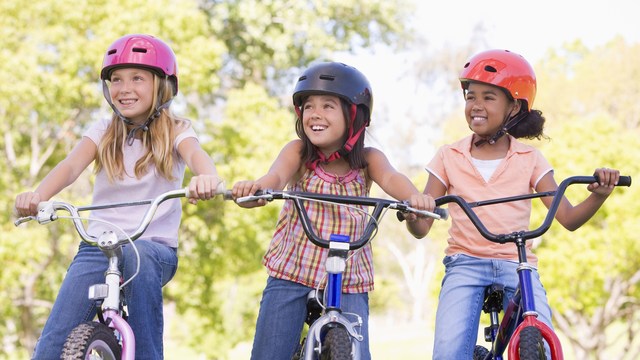 MonkeyBusiness Images/PhotoSpin
MonkeyBusiness Images/PhotoSpin
Cycling is a great summertime family activity. Children are excited to find out they can go so fast and go places on their own. It can also be very frightening for parents.
That’s why it’s important to make sure you teach your child proper bike safety rules and practices from the beginning. Then you can be relatively sure your child is safe when he/she goes out without you.
To ensure your child cycles safely, it is important to follow these rules and guidelines:
1) A bike helmet is essential bicycle safety gear, and children need to be taught that this is a non-negotiable part of riding a bike. Not only will it protect your child’s head, it is also law in many states and cities across the United States.
It is important to establish helmet wearing at the beginning so the child understands that it’s normal and needs to happen every time, like putting on a seatbelt in the car. It should fit snugly, not tightly, and should sit properly on your child’s head.
Many cities actually give away bike helmets and will fit them properly for your child free of charge.
2) Children under the age of 10 should ride on the sidewalk, not the road. However, it’s best to check with your town/city’s/state’s law. In some places it is illegal to ride on the sidewalk.
3) When choosing a bike, it’s important to choose one that’s not too big or too small for your child. Children between the ages of 18 months and 5 years can use a bike with 12” wheels, while 16” wheels are designed for children between the ages of 4 and 7.
The National Highway and Traffic Safety Administration recommends that, with your child standing over the bike, “[t]here should be 1 to 2 inches between [the child] and the top tube (bar if using a road bike) and 3 to 4 inches if a mountain bike. The seat should be level front to back. The seat height should be adjusted to allow a slight bed at the kneed when the leg is fully extended. The handlebar height should be at the same level with the seat.”
4) Another bicycle safety standard in many places is a bell or horn on the bike. If it is not law in your area, it’s still a good idea because it will allow your child to alert any pedestrians or vehicles that there’s a bike nearby.
5) It is important to inspect the bike’s tires and brakes every season to make sure they’re working properly. Replace any lines or pads as necessary and make sure that the tires are properly inflated and don’t have any holes.
6) It is critical that you teach your child to watch for cars and other vehicles turning into and out of driveways.
7) Children also need to know to stop at stop signs and street lights even if they’re riding on the sidewalk, and that it’s best to walk the bike across the street at an intersection -- not ride it. Children need to understand that their bike is considered a vehicle and they must obey the traffic laws that come with riding one.
9) Children should also be taught to use turn signals.
Cycling is a fun family activity that can be done for a lifetime. That’s why it is critical that children learn the rules of bicycling safety at a young age.
Sources:
1) Kids and Bicycle Safety. National Highway and Traffic Safety Administration. Web. May 22, 2014.
http://www.nhtsa.gov/people/injury/pedbimot/bike/kidsandbikesafetyweb/index.htm
2) Bicyclists. New York City Department of Transportation. Web. May 22, 2014.
http://www.nyc.gov/html/dot/html/bicyclists/biketips.shtml
3) Kid’s Bicycle Safety Guide. Cyclesport.com. Web. May 22, 2014.
http://www.cyclesport.com/kids-bicycle-safety-guide
4) Safety Tips for Bicyclists and Motorists. California Department of Motor Vehicles. Web. May 22, 2014.
http://www.dmv.ca.gov/pubs/brochures/fast_facts/ffdl37.htm
Reviewed May 22, 2014
by Michele Blacksberg RN
Edited by Jody Smith






Add a CommentComments
There are no comments yet. Be the first one and get the conversation started!